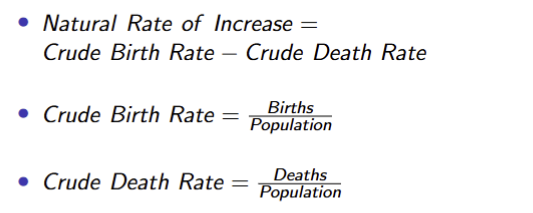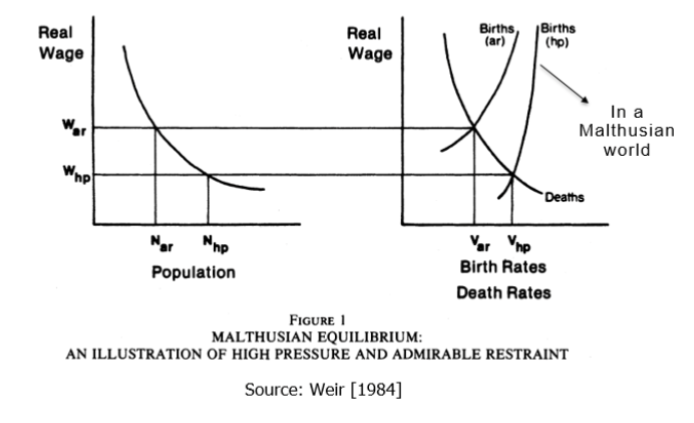6 - Pre-modern growth - the Great Divergence - WHY
1/20
There's no tags or description
Looks like no tags are added yet.
Name | Mastery | Learn | Test | Matching | Spaced |
|---|
No study sessions yet.
21 Terms
Why did Europe diverge from Asia - Classical/Traditionalist School?
china has different demographic characteristics
China had poor gov institutions
china was less urban and more commercialised
China has less productive agriculture
china has expensive energy sources
China was less innovative - hence lower productivity
China had poor informal/cultural institutions
What do we mean by a different demographic regime btw China and Europe?
china has universal marriage (women)
Births and deaths were hogher in China
population suffered from famines as laste as the 19C (and later)
China may have had lower real wages due to institutions governing marriage and fertility
Chinese demographic characteristics did not change in this period
Hence changes in England/Europe reflect different demographics
How did the demographics differ?
Englands pop pattern was unique in a number of ways
europe was the first to undergo the “demographic transition” (high birth rates and death rates to low birth rates and death rates)
Europe differed from the rest of the world - fertility was central
England differed from the rest of Europe - nuptiality was central
What is the equation for natural rate of increase of a population

What is Crude Brith Rate (CBR) determined by and what is the maximum?
determined by fertiluty rates of married and unmarried women, the marriage rate and femal age of first marriage (FAFM)
Max CBR is about 50/1000 based on traditional communities
What is Crude Death Rate (CDR) determined by and what is the maximum?
determined by war, famine, plague, etc.
characterised by sudden peaks as high as 150/1000, 300/1000 and even 5000/1000
How was England’s fertility throughout history?
fertility was not at its biological max sinxe 1541 = CBR was approximately 30/100 from 18C (CBR was 49/1000 for sub-Saharan Africa in the 1980s)
Femal age of first marriage (FAFM) was high in England
Englands FAFM was 23.1 from 1800-1837 vs 16 for Bangladesh in 1970
Celibacy was high - 10-15% of women never married vs close to 0% for 20C LDCs
Illegitimacy was low - unmarried fertility rate was relatively minor
fertility does appear to have been linked to wages before the 18C but became disconnected from income in the 18C
What were the equilibrium forces on population on the Malthusian Theory?
Positive checks
events that increase mortality (war, plague, famine etc)
The mechanism of lower average income societies
Malthus argued that Asia relied on “positive” checks
Preventative checks
Events that lower fertility (abstinence, delayed marriage)
The mechanism of higher average income societies
Malthus argued W Europe relied on preventative checks
What is empirically correct - explaining the Great Divergence?
famous study by Hajnal (1965) looked at fertility
key aspects were age of marriage and the proportion of single women
W. Europe has a lower marriage rat and higher FAFM
confirmed W Europe relied on preventative checks
area seperating W europe from the rest of the world was called the “Hajnal Line”
NW Europe was distinct from the rest of Europe as it limited nuptiality - Italy, France, Spain etc. limited fertility within marriage
Why did Hajnals findings of preventative checks in W Europe matter?
Allen (2009) argues that a more elastic CBR was key to European Success
W Europe has higher wages due to preventative checks
Higher wages meant high labour costs for industry
This spurred industrialisation by promoting labour-saving technology
The IR was impacted by this K intensive technological change - Solovian growth
Specialisation and organisation of production is easier along K intensive path - Smithian growth
Europe and Asia were on different demographic paths
What do 2 stable equilibria in the Malthusian model look like?

What aspects of government might have mattered to the Great divergence?
china was very centralised
Chinese bureaucracy faced no challenge from independent aristocracy, church, judiciary, military, etc.
Lack of institutional tensions equated to little institutional change
bureaucracy prevented emergence of an indepedent commerical and industrial class
europe has decentralsied governments, powerful aristocracies and merchants and churches
Why do these differences in gov matter?
Why do we have governments?
Theory of Bandits (Olson 1993)
consider a world in anarchy with roving bandits
no incentive for anyone to produce beyond subsistence
Society will seek security but free-rider problem wil prevent cooperation
Eventually an enterprising bandit decides to monopolise theft - regular raxation
this roving bandit becomes stationary so it can tax regularly no need to bother roving any more
Not the worse situation
Roving bandits
why are stationary bandits better than roving bandits?
lower taxation encourages greater production since ppl keep some for themselves
lower taxes on higher output means greater revenue than full taxation (theft)
Roving bandits tax everything T*(R)
Stationary bandits maximise revenye at a low tax rate T*(S)
Stationary bandits will provide public goods
Citizens are protected (military and police) as a source of revenue
It is in the Bandits best interest to be stationary but everyone benefits
Was this the best we could expect? what is wrong with an autocrat?Compare this with democracy
Why is democracy better than stationary Bandit?
Olsen has 2 main arguments for democracy:
Production argument
society itself acts like an autocrat
MB = MC will occur at a lower (net) tax rate
Competition argument
leaders have an incentive to sacrifice some reveny to win an election
Others are competed down to the minimum reveny for winning
What is Olsen’s Government theory?
Explains the Great divergence
we can see how a roving bandit becomes stationary but Why would they become democratic and how did Europe fit into this story
Europe was not particulalry fast in transitioning to autocracy - china was autocratic with a central bureaucracy
Europe was fast transitioning towards democracy - the English glorious revolution of 1688
Timing suggests that this transition towards democrcay may have caused the great divergence
So what changes took place at the end of the 17C in England/ Europe
What was the glorious revolution?
The english Glorious Revolution of 1688 - institutional change - helped to make England first industrial nation - Pincus and Robinson (2011)
some suggest Glorious revolution of 1688 launced the great divergence
William of Orange (Dutch) took the throne from JamesII in 1688
done at the request of parliament and realigned the power of the English constitution
Balance of power btw the parliament and co-monarchy of William and Mary made the gov more credible
There was then significant debate over the effect of institutions and LR growth
North and Weingast (1989) argue that the GR led to credible property rights, protection of wealth and elimination of confiscatory gov
Why did the glorious Revolution happen?
Issues dividing King and Parliament before 1688
Royal finances - revenues, expenditures - independence vs approval
Judiciary - not a seperate branch - royal punishment vs parliamentary impeachment
Civil War 1642-58 - dicretionary rule
Restoration of the monarch 166- with Charles II problems subsist
Charles ousted in 1688 - William and Mary offered crown upon conditions + a new constitution 1688 (institutional change)
GR did more than just fix the crowns financial problems - it helped constrain the executive
Did the Glorious Revolution matter empirically?
Evidence in literature:
gov ability to borrow (confidence) increased (Debt)
Capacity of gov to provide services increased (revenues)
Gov employment increased (larger bureaucracy)
Gov investment in infrastructure increased
Govs role in legislating was increasing
Why did British State Capacity matter?
Domestic view (“night-watchman state”) - minimal involvement
focus is on the financial revolution - taxation, borrowing and dfinancial institutions
Gov was laissez-faire - taxation was low and little redistribution
democracy increased property rights and lowered transaction costs
Regulation was almost non-existent (labour marjets and trade)
Foreign view (“fiscal-military state)
government borrowed to expand the navy and colonial armies - trade opportunities and empire
strong state created good institutions (common law and constitution)
Both military and political changes facilitated markets and generated tech change to launch IR
Efficiency, Culture and Institutions
clark claims that deficiencies in tech transfer, management skills or input markets cannot explain the productivity gap btw NW Europe and Asia
He suggests instead that differences in informal institutions governing work ethics and effort (labour inefficiencies) are key
His evidence compares cotton textile workers in Engalnd with Asia
Others have looked at rail roads in England vs Asia that both employed English technology and management with differing performance
Others have suggested that Confucianism may have limited growth or tech change